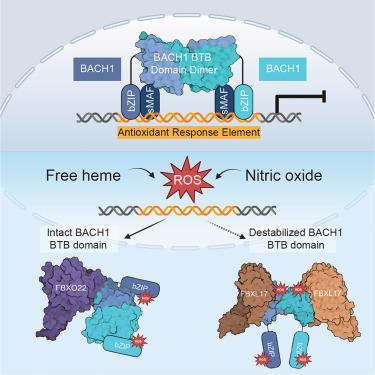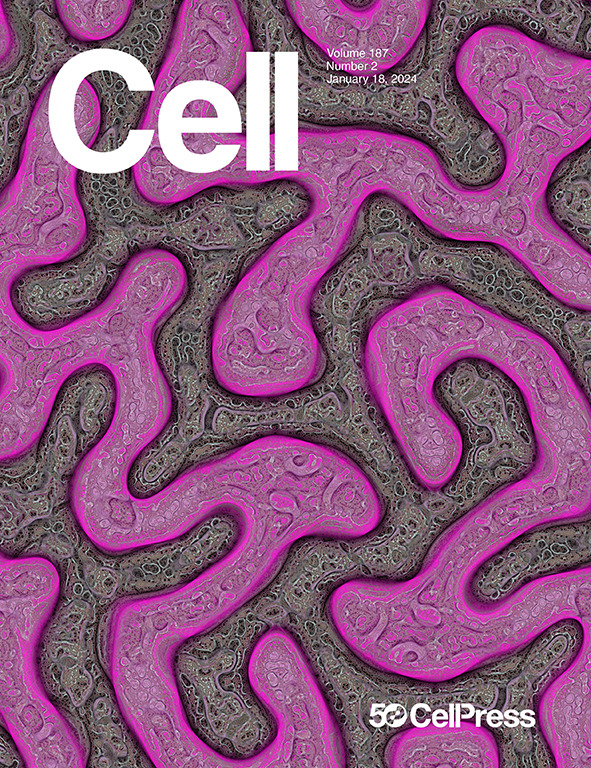Recognition of BACH1 quaternary structure degrons by two F-box proteins under oxidative stress
IF 45.5
1区 生物学
Q1 BIOCHEMISTRY & MOLECULAR BIOLOGY
引用次数: 0
Abstract
Ubiquitin-dependent proteolysis regulates diverse cellular functions with high substrate specificity, which hinges on the ability of ubiquitin E3 ligases to decode the targets’ degradation signals, i.e., degrons. Here, we show that BACH1, a transcription repressor of antioxidant response genes, features two distinct unconventional degrons encrypted in the quaternary structure of its homodimeric BTB domain. These two degrons are both functionalized by oxidative stress and are deciphered by two complementary E3s. FBXO22 recognizes a degron constructed by the BACH1 BTB domain dimer interface, which is unmasked from transcriptional co-repressors after oxidative stress releases BACH1 from chromatin. When this degron is impaired by oxidation, a second BACH1 degron manifested by its destabilized BTB dimer is probed by a pair of FBXL17 proteins that remodels the substrate into E3-bound monomers for ubiquitination. Our findings highlight the multidimensionality of protein degradation signals and the functional complementarity of different ubiquitin ligases targeting the same substrate.

两种 F-box 蛋白在氧化压力下识别 BACH1 四元结构脱氧核苷酸
泛素依赖性蛋白水解以高度的底物特异性调节多种细胞功能,这取决于泛素E3连接酶解码目标降解信号(即degrons)的能力。在这里,我们发现抗氧化反应基因的转录抑制因子 BACH1 在其同源二聚体 BTB 结构域的四元结构中加密了两个不同的非常规降解子。这两个去凋亡子在氧化应激作用下都会发生功能化,并被两个互补的 E3s 所破译。FBXO22 可识别由 BACH1 BTB 结构域二聚体界面构建的一个降解子,当氧化应激将 BACH1 从染色质中释放出来后,该降解子就会从转录共抑制因子中解除屏蔽。当这一降解子因氧化而受损时,由其不稳定的 BTB 二聚体表现出的第二个 BACH1 降解子就会被一对 FBXL17 蛋白探测到,后者会将底物重塑为 E3 结合的单体以进行泛素化。我们的研究结果突显了蛋白质降解信号的多维性以及不同泛素连接酶针对相同底物的功能互补性。
本文章由计算机程序翻译,如有差异,请以英文原文为准。
求助全文
约1分钟内获得全文
求助全文
来源期刊

Cell
生物-生化与分子生物学
CiteScore
110.00
自引率
0.80%
发文量
396
审稿时长
2 months
期刊介绍:
Cells is an international, peer-reviewed, open access journal that focuses on cell biology, molecular biology, and biophysics. It is affiliated with several societies, including the Spanish Society for Biochemistry and Molecular Biology (SEBBM), Nordic Autophagy Society (NAS), Spanish Society of Hematology and Hemotherapy (SEHH), and Society for Regenerative Medicine (Russian Federation) (RPO).
The journal publishes research findings of significant importance in various areas of experimental biology, such as cell biology, molecular biology, neuroscience, immunology, virology, microbiology, cancer, human genetics, systems biology, signaling, and disease mechanisms and therapeutics. The primary criterion for considering papers is whether the results contribute to significant conceptual advances or raise thought-provoking questions and hypotheses related to interesting and important biological inquiries.
In addition to primary research articles presented in four formats, Cells also features review and opinion articles in its "leading edge" section, discussing recent research advancements and topics of interest to its wide readership.
 求助内容:
求助内容: 应助结果提醒方式:
应助结果提醒方式:


